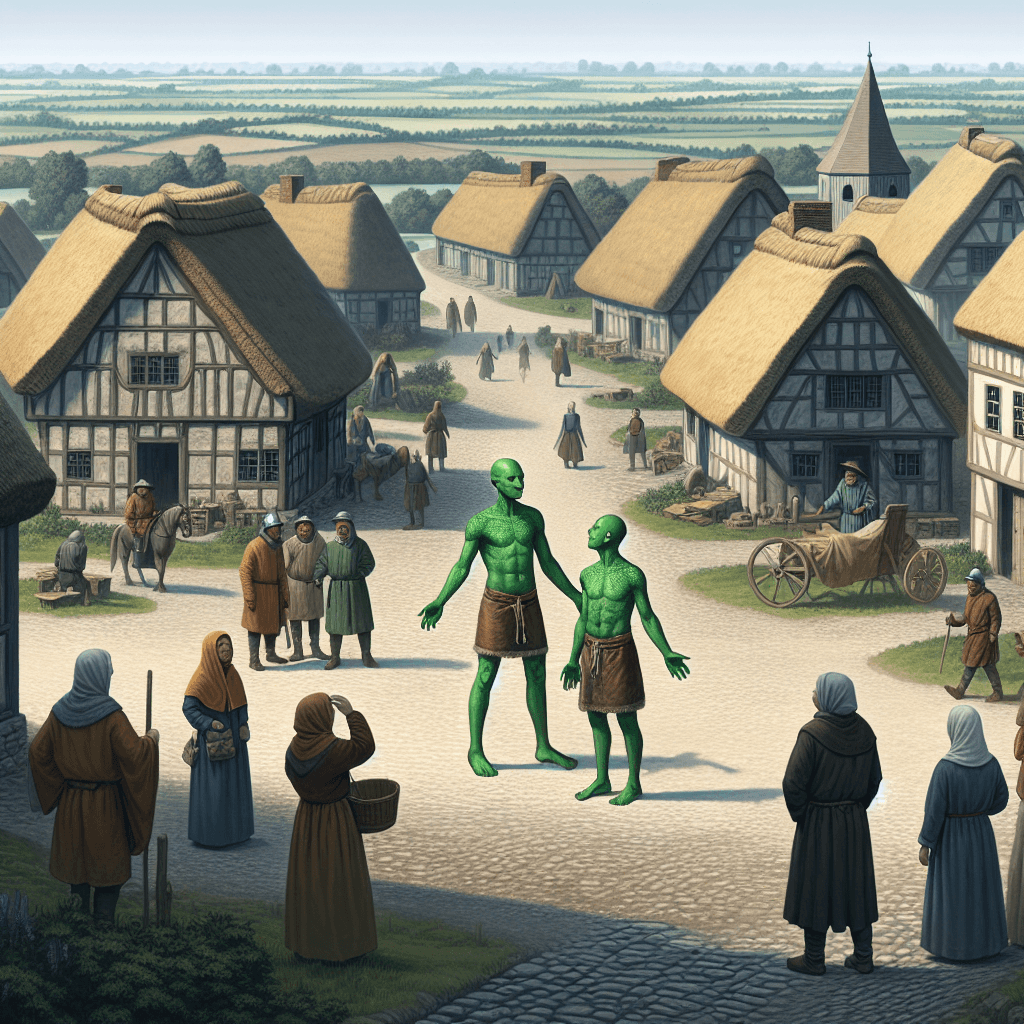Why did a medieval village report the sudden appearance of two green-skinned children
They appeared in a 12th-century English village with baffling green skin and a story about coming from a land of perpetual twilight—and this isn't a fairy tale.


Too Long; Didn't Read
TLDR: The green children were likely two lost and malnourished immigrant kids whose sickly skin color and foreign language were interpreted by superstitious medieval villagers as a supernatural event, creating a local legend.
The Green Children of Woolpit: Why Did a Medieval Village Report Two Mysterious Green-Skinned Children?
Imagine a quiet, 12th-century English village, its predictable harvest-time routine shattered by an impossible discovery. Near one of the deep pits used to trap wolves, villagers found two children, a boy and a girl, huddled together. They were dressed in strange, unfamiliar clothes and spoke a language no one could understand. But most astonishingly, their skin was a distinct, unnatural shade of green. This is the enduring legend of the Green Children of Woolpit, a story that has baffled historians and folklorists for nearly 900 years. This post will delve into the historical accounts of this strange event and explore the most plausible explanations for why a medieval village reported the sudden appearance of two green-skinned children.
The Tale as Told by Chroniclers
The story isn't just a local fairy tale; it was documented by two respected English chroniclers of the time, writing within a few decades of the reported event. Both Ralph of Coggeshall and William of Newburgh recorded the incident, lending it a rare degree of historical credibility for such a bizarre tale.
According to their accounts, which largely corroborate each other, the children were brought to the home of a local knight, Sir Richard de Calne. They refused all food until they were offered raw broad beans, which they ate voraciously. The boy, who appeared younger and sickly, soon died. The girl, however, adapted to her new life. Over time, she:
- Learned to eat other foods, and her green skin gradually faded to a normal complexion.
- Was baptized and learned to speak English.
- Eventually explained that she and her brother came from a place called "St. Martin's Land," an underground world where the sun never shone and everything was green.
She claimed they had been herding their father's flock when they heard a loud sound like bells and found themselves lost in a cave, eventually emerging into the bright sunlight of Woolpit.
Unraveling the Mystery: The Leading Theories
While the story sounds like pure fantasy, several compelling theories attempt to ground the legend in reality. These explanations range from otherworldly folklore to plausible medical and historical circumstances.
The Folklore and Otherworldly Explanations
In an era steeped in superstition, the most immediate conclusion for the villagers would have been supernatural. The children were often interpreted as fairies, elves, or beings from another dimension who had stumbled through a portal into our world. The "wolf pits" themselves were often seen in folklore as liminal spaces between worlds. The girl's own account of St. Martin's Land, a subterranean Christian paradise, fits neatly into the mythological worldview of the medieval period. In modern times, this theory has evolved, with some suggesting the children were extraterrestrials.
The Historical and Scientific Explanations
While less romantic, fact-based theories provide a more convincing answer to the mystery. The most widely accepted explanations combine historical context with a known medical condition.
-
Flemish Immigrants: During the 12th century, there were significant communities of Flemish immigrants (from modern-day Belgium) in eastern England. They were skilled weavers and farmers, but faced persecution under King Henry II. It's theorized that the children were orphans whose parents were killed in this conflict. Fleeing into the dense Thetford Forest, they could have become lost and disoriented. This would explain their "strange" language (a form of Dutch), unfamiliar clothing, and their appearance in Woolpit after wandering from a nearby Flemish settlement.
-
Hypochromic Anemia (Chlorosis): This is the key to their green skin. Hypochromic anemia, often called "green sickness," is a very real condition caused by severe iron deficiency and malnutrition. It gives the skin a noticeable green pallor. If the children had been living on a severely restricted diet while lost in the forest, they could easily have developed this condition. The girl's skin returning to normal after adopting a balanced diet perfectly matches the prognosis for chlorosis. Their initial refusal of all food except raw beans—the first familiar food they saw—also points to extreme malnourishment and trauma.
Conclusion
The legend of the Green Children of Woolpit endures because it operates on multiple levels. It is a captivating fairy tale, a glimpse into the medieval imagination, and a fascinating historical puzzle. While we will never know the exact details with certainty, the evidence strongly suggests a very human tragedy lies at its core. The most logical explanation is that two lost, traumatized, and severely malnourished Flemish children stumbled out of a forest into a village that could only explain their strange language, clothes, and anemic complexions through the lens of the supernatural. The story serves as a powerful reminder of how reality, when viewed through the prism of a different time, can easily become the stuff of legend.
More Articles

Why do things underwater look bigger and closer than they really are?
It’s not your eyes playing tricks on you—it's a fascinating law of physics that turns the entire underwater world into a giant magnifying glass.

Why do spaghetti stains cling to plastic tubs but not glass bowls?
Discover why tomato sauce permanently dyes your plastic containers but wipes clean from glass—it's not your scrubbing power, but a simple case of molecular attraction.

Why was a brilliant philosopher's name twisted into the modern word for a fool?
He was a celebrated intellectual giant, yet a centuries-long smear campaign by his academic rivals twisted his very name into a common insult for a fool.